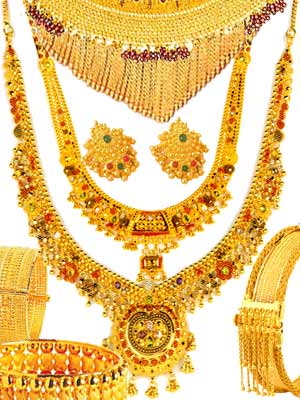Indian Bridal Jewelry
Indian brides wear jewelry sets that are made in gold, be it necklaces, bangles, anklets and earrings. Many a time, the bridal jewelry is set with diamonds and other precious stones. The modern day bride prefers to have some modern wearable items of gold jewelry in her trousseau. Not many would like to be weighed down by heavy jewelry that cannot be worn often and will be more an invitation for thieves. Come the wedding season and you can see crowds thronging the jewelry stores. Indian bridal jewelry has always been considered her 'streedhan' - personal wealth that would stand in good stead in times of need.
Indian jewelry for brides is created to enhance the beauty of the woman. The gentle tinkle of the anklets around delicate feet, a set of jingling bangles on her hands and an exquisitely crafted necklace round her neck - the Indian bride looks resplendent in her finery and colorful profusion. Some bridal ornaments such as waistbands and armlets are seldom worn these days.

Indian bridal jewelry varies from region to region as well as different communities. Precious stones such as jade, garnet, emerald, amethyst, pearl and coral are widely used in Indian bridal jewelry. Stones are said to pass their own special healing touch to the wearer. The precious stones are said to have an effect on one's blood vessels and temperament. Use of navarathnas or nine precious stones can be seen in finger rings and earrings.
The mangal sutra is an important item in the bridal jewelry. This necklace is tied by the husband around the wife's neck as a symbol of their union. This is usually created on a necklace strung with black beads. It is considered a protection against the evil eye. Many a bride makes a few changes to suit her tastes, keeping well within the prescribed parameters.
The conventional gold pendant is often replaced with a diamond. The length of the mangalsutra is one of personal preference. Black beads are sometimes interspersed with gold beads. South Indian brides wear silk saris that are offset by exquisite jewelry in gold. Bridal jewelry encrusted with rubies, emeralds or pearls is popular. The south Indian women wear a thaali as a symbol of their marriage. This is usually in the form of a thick yellow thread with gold pendant.
Brides from Maharashtra wear stings of pearls in a cascade from the temples down to the shoulders, framing the face. The Punjabi bride wears bangles that are made of ivory. The parting of her hair is decorated with a gold ornament called the tikka. Red and green bangles or churas are important in many communities of India. They are given by the bride's mother and it is customary to wear them for about 40 days after the wedding ceremony.
Some churas are set in ivory with inlay work done on them. Toe-rings are another jewelry item that is worn by married women in many parts of the country. The women from Uttar Pradesh and Bihar wear toe-rings called bichwa. Kashmiri women wear a long suspended cord with an ornament from the pierced ears. Brides from Bengal wear the iron kada or bangle called 'loha'. This is artistically encased in gold. A red lac bangle is yet another important bridal jewelry item.
Fine filigree jewelry in silver is a hallmark of the artisans of Orissa and Andhra Pradesh. Filigree work uses silver wires of varying thickness to make geometrical shapes, leaves, flowers and butterflies and birds. Jaipur is famous for enamel work - exquisite bangles and necklaces with colored enamel paneling on crafted gold.
Kundan jewelry also finds favor with many Indian brides.Kundan jewelry is characterized by gems embedded in gold leaf and not rim or claw. This jewelry style is inspired by the Mughals. Temple jewelry from South India is inspired by temple statues and motifs and is usually characterized by red and green semi precious stones. Jewelry in the southern states is inspired by nature - paisley motifs, rice grains, melon seeds, cobra head and birds.









